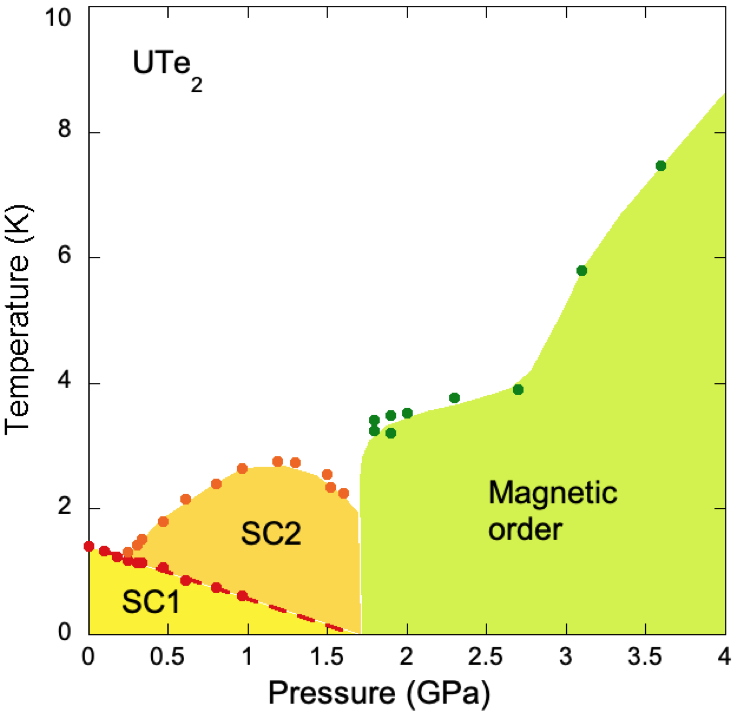The recently discovered superconductor UTe
2[1,2] reveals a multitude of rare and surprising properties. The most spectacular is that despite the relatively low superconducting critical temperature T
SC=1.7K, superconductivity survives up to extremely high magnetic fields, as high as 60T. This arises from a pronounced field-induced reinforcement of superconductivity, occurring when the magnetic field is applied along specific crystallographic directions. Although this extraordinary result is not yet fully understood, it is clear that the mechanism responsible for the pairing of electrons and superconductivity is probably of magnetic origin rather than the usual electron-phonon interaction. The explanation of the unusual superconducting properties of UTe
2 must be sought in its highly anisotropic magnetic properties, with notably the existence of a first order metamagnetic transition at 34T. Hence, the study of UTe
2 already requires the combination of 2 extreme conditions parameters, namely low temperatures and very high magnetic fields. We discovered that even more surprises are to be found by adding a third parameter: high pressure.
The dominant effect of applying pressure in strongly correlated electron systems is to modify the electronic and magnetic interactions. In UTe
2, we have shown that T
SC increases almost by a factor 2, reaching about 3K at a moderate pressure of about 1.3 GPa. At higher pressures superconductivity is rapidly suppressed indicating a strong competition between the superconducting and magnetically ordered phases. Indeed, a pressure of less than 2 GPa induces a long range magnetically ordered state at low temperature. More interestingly, our experiment combining calorimetry as a probe for superconductivity and
in-situ pressure tuning allowing very fine pressure changes, revealed a complex behavior of the superconducting state above 0.3 GPa: in this pressure range, we found not one but two distinct successive superconducting transitions as a function of temperature. This is a very rare phenomenon. It implies a change of the superconducting order parameter within the superconducting state
[3], leading possibly to a state mixing spin singlet and spin triplet pairing. Another central open question is whether there is a link between the enhanced superconducting state induced by pressure and that induced by magnetic field. Further experiments are on the way to tackle this issue.

Phase diagram of superconducting and magnetic phases of UTe2 under pressure. A resistivity measurement only detects the upper superconducting transition temperature, but the calorimetry study performed here reveals a transition within the superconducting state, probably between two distinct superconducting order parameters. The nature of the magnetic order appearing above 2 GPa has not yet been clarified, but it is clearly competing with superconductivity.